The origin of churros can be traced to the Moors who brought a dish by the name of tueles to the Spanish territories. After a slow start, the Spanish cuisine adopted the Moorish dish and incorporated their own elements like additional sugar or chocolate, naming it churros. Due to the colonial influence of the Spaniards, the dish spread across the world rather quickly. Today, churro cuisine is further developed through the introduction of churro bowls and new fillings.
Table of Contents
What is the Origin of Churros?
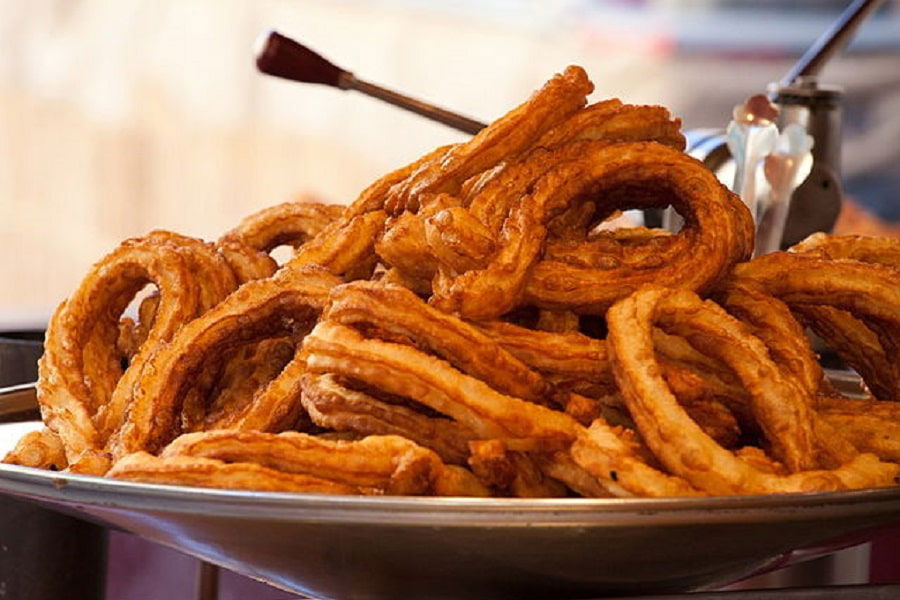
Churros, the delectable fried dough pastries enjoyed around the world, have a fascinating origin rooted in Spanish culture. In a nutshell, it is believed that churros originated from a pastry called teules, introduced to Spain by the Moors during their occupation. While originally a breakfast or snack for Spanish shepherds, churros gained popularity and spread throughout Spain, eventually making their way to Latin America and other parts of the world.
Over time, the Spanish transformed the teules into the elongated, star-shaped churros we know today. With their crispy exterior and soft, doughy interior, churros have become an irresistible treat loved by people of all ages.
Teules and the Moors
Teules has a fascinating history that is drenched in the Moors’ influence on Spanish culture. The Moors, who were Muslims of Arab and Amazigh descent, occupied the Iberian Peninsula for nearly eight centuries, from the early 8th to the late 15th century.
During their rule, the Moors brought with them a rich culinary heritage that left a lasting impact on Spanish culture, including their cuisine. They actually had a profound influence on Spanish gastronomy, introducing new ingredients, spices, and cooking techniques. Their love for fried pastries was part of their culinary repertoire.
During this time, they spread their sweet treat called teules, also known as tejeringos or calentitos, around the area. They were deep-fried pastries made from a simple dough mixture of flour, water, and salt. Typically, they were shaped into small rings or spirals and were enjoyed as a sweet indulgence.
The Moors’ occupation of the Iberian Peninsula created a unique fusion of cultures and culinary traditions. The Spanish people were quick to embrace the diverse influences, incorporating the flavors and techniques of the Moors into their own culinary practices.
The Spanish began to adapt and modify the original Moorish recipe, transforming the fried food into what is now recognized as churros.
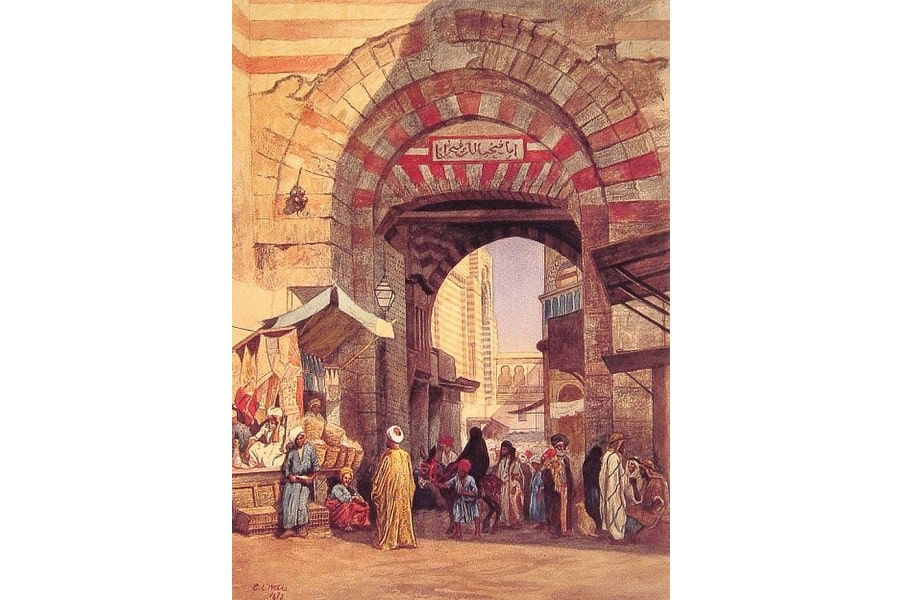
From Tueles to Churros
The evolution of teules into churros involved a few key changes. The most significant alteration was the shape. The original tueles were typically ring-shaped or spirals, whereas churros were rather elongated and star-shaped fried dough sticks.
This transformation is said to have been influenced by the Spanish shepherds, who used the dough as a portable and convenient meal during their long days in the fields.
Additionally, the Spanish version of churros incorporated a sprinkling of sugar or a dusting of cinnamon on top, which enhanced their flavor and made it an even sweeter snack. This addition became a defining characteristic of churros, setting them apart from their Moorish predecessors.
The Spanish also developed the tradition of churro dunking. Normally, this would be done in thick, rich chocolate. Nowadays, churros con chocolate remains a popular pairing.
After Adoption by the Spaniards
As churros gained popularity in Spain, they became a beloved treat enjoyed by people from all walks of life. Street vendors and churrerías, which are specialized churro shops, began to emerge, selling freshly fried churros to their customers. Churros became a staple of Spanish culture, often consumed for breakfast or as a snack.
With the expansion of Spanish influence during the age of colonization, churros eventually found their way to Latin America and other parts of the world. In these regions, churros were embraced and adapted to local tastes, with variations emerging such as filled churros and churros with different coatings or toppings.
READ MORE: Who Discovered America: The First People Who Reached the Americas
Today, churros continue to captivate taste buds worldwide. Whether enjoyed plain, dipped in chocolate, or accompanied by various fillings and toppings, churros are a symbol of indulgence and culinary delight.
While the actual teules aren’t served anymore, their legacy lives on through the enduring popularity of churros, serving as a testament to the dynamic and diverse nature of culinary evolution.
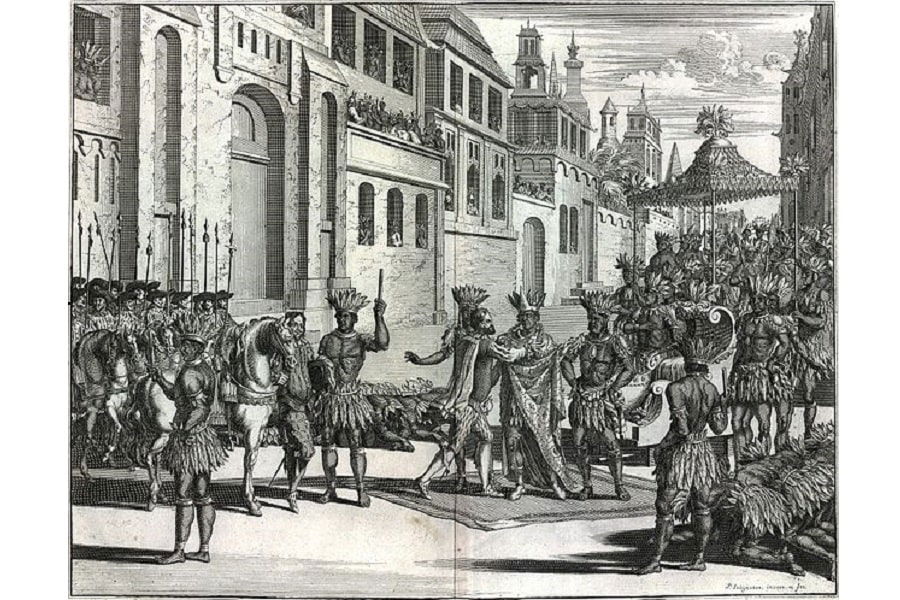
A Historic Breakfast
As indicated earlier, the history of churros as a breakfast or snack for shepherds is a charming aspect of their origin. In rural Spain, particularly in the Andalusian region, shepherds led a nomadic lifestyle, herding their flocks across vast expanses of land.
Before the churros, the breakfast of the Spanish shepherds consisted of fresh bread. However, baking bread every morning is quite a time-consuming activity. Especially when you have to roam the lands all day after.
Because of that, they were searching for portable and filling food that could sustain them during long days of tending to their sheep. Churros proved to be an ideal solution. The dough was simple to prepare with just some basic ingredients, and the elongated shape made them easy to carry.
Shepherds could whip up churros quickly, fry them over an open fire, and enjoy a warm and satisfying treat on the go. Additionally, the versatility of churros also played a role in their popularity among shepherds. This simplicity made churros a cherished part of the shepherds’ daily routine.
Spread Beyond the Rural
Over time, churros’ reputation spread beyond the rural areas, and they started to gain popularity in towns and cities across Spain. Churro vendors began to set up stalls in markets and public squares, attracting people from all walks of life with the intriguing aroma of freshly fried churros.
As their popularity grew, churros evolved from being a humble shepherd’s snack to becoming a beloved treat enjoyed by people of all social classes. Today, they have become a symbol of Spanish cuisine; a cherished dessert often served with a side of thick, rich hot chocolate or a sprinkle of sugar and cinnamon.
The humble origins of churros as a sustenance for shepherds add a sense of nostalgia and warmth to this beloved pastry. Despite their long journey through history and transformation into a popular delicacy, churros still carry the essence of their rustic beginnings.
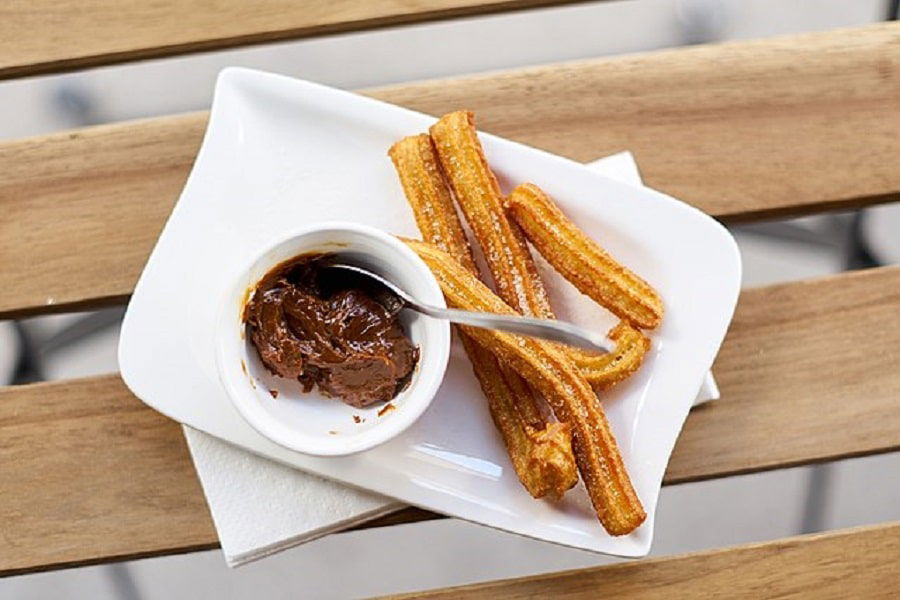
Who Invented the Churros?
Still, the exact origins of churros and the name of their specific inventor are not well-documented. As indicated, churros are believed to have evolved over time from the Moorish tueles. The development of tueles into churros was likely a collective effort, influenced by various cultural exchanges and culinary traditions. It’s impossible to credit one specific individual with inventing churros, as they evolved over centuries.
There are also alternative theories regarding the origin of making churros, adding an intriguing layer to their messy past. One theory suggests that churros have roots in China, with a pastry called youtiao serving as the predecessor.
Youtiao is a salty-fried pastry that lacks the characteristic pairing with chocolate or cinnamon. It is served with rice congee or soy milk dip. Portuguese sailors actually set sail to Chinese territories, which speaks to the potential validity of this alternative theory.
The argument is that Portuguese explorers brought youtiao back to Spain after they encountered it in China during their travels. Over time, it transformed into the star-shaped dessert we now recognize as churros and gained popularity throughout the country.
It’s hard to point to one right answer, both the Portuguese traders and the Moors can make an argument to be the inventors of today’s churro. Yet, the Moors were in Spain for quite a long time – more than seven centuries. The combination of their presence and their traditions of teules are pretty convincing arguments in favor of the Moorish theory.

Popularity and Spread of Spanish Churros
The development of churros as a national dish coincided with the rise of street food culture in Spain. In the late 19th and early 20th centuries, street vendors known as churreros or churrerías began to emerge in cities and towns, specializing in selling freshly fried churros.
These vendors quickly became an integral part of the Spanish culinary scene, transforming churros into popular street food. Actually, the churrerías became bustling gathering spots, attracting people from all walks of life to enjoy the delicious treat.
Families, friends, and workers on their way to or from their jobs would stop by a churrería to savor the traditional churros. The affordability and accessibility of churros played a significant role in their popularity as street food. They were relatively inexpensive, making them accessible to people from all socio-economic backgrounds.
Manifesting a Churro Culture
As the popularity of churros as street food grew, they became deeply ingrained in the cultural fabric of Spain. It wasn’t particularly hard to find churros, since stalls and churrerías became fixtures in every city and town. Today’s churros became synonymous with festivities, carnivals, and special events, adding a touch of indulgence to the celebratory atmosphere.
Churros eventually transcended Spain’s borders, spreading to other parts of the world through Spanish immigrants. Latin America, in particular, embraced churros as a culinary delight.

Are Churros Originally from Spain or Mexico?
Because churros are sold all across Mexico, it is often presumed that fried food originated in this country. However, it was only after the Spaniards arrived that Mexicans were in contact with churros for the first time. They adopted the dish and made it their own. Nowadays, there are ample Mexican variations to the dish. The actual origin of the dish is still Spanish.
In recent years, the popularity of churros as street food has reached even greater heights as it seems to have become one of the many food trends. Churro trucks, pop-up stands, and food festivals have further propelled the churro craze.
Churros have become a symbol of celebration, joy, and the vibrant street food culture that is an integral part of Spain’s culinary identity. Today, churros continue to captivate taste buds worldwide. Whether enjoyed as a nostalgic childhood treat, a decadent dessert, or a quick street snack, churros remain a beloved snack for any sweet tooth.
How Did Churros Spread around the World?
While churros originated in Spain, the spread of churros beyond Spain can be attributed to the colonial explorations and influence of the Spanish empire. As the Spaniards started colonizing the Americas, Spanish explorers brought churros with them.
The Spanish Inquisition invaded the Americas in the late 15th century. Churros quickly gained popularity in the region, becoming a part of the local culinary landscape. The local population was quick to adapt the dish to the tastes and preferences of the Latin American population.
The Spanish influence on Latin American cuisine, which is known as Criollo cuisine, was profound. The introduction of ingredients, cooking techniques, and recipes from Spain significantly shaped the food culture of Latin America. Churros became one of the culinary treasures inherited from the Spanish colonizers.
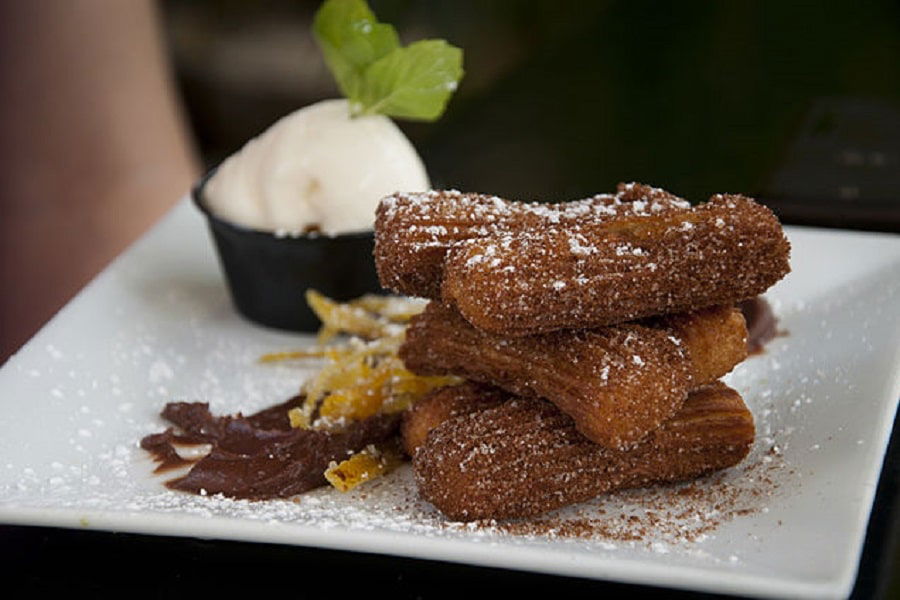
Variation and Spread in Latin America and Beyond
In Latin American countries, churros developed their own regional variations and adaptations. This helped with the spread of the dish so that it can now be enjoyed in many countries around the world. Each country added its own unique twist to the traditional recipe, incorporating local flavors and ingredients.
For example, in Mexico, churros are often served with a sprinkle of cinnamon sugar and accompanied by a side of thick, rich chocolate for dipping. In Argentina, churros are elongated and a bit thinner, often served with a caramel-like sauce on the side.
The popularity of churros as street food in South America grew in parallel with the street food culture that emerged in bustling cities and towns. Churro vendors and stalls, similar to the churrerías in Spain, became part of the street view in local markets, plazas, and fairs.
They became a beloved treat enjoyed by people from all walks of life, whether as a special indulgence or a popular street food snack. The spread of the dish continued as Latin American communities expanded and migrated to different parts of the world.
Different Types of Churros
The history of churros and their global popularity has everything to do with the versatility and adaptability of the dish. The simple yet delicious combination of fried dough with sugar, cinnamon, and various accompaniments has resonated with people worldwide, leading to its widespread recognition as a delectable street food and dessert option.
Filled Churros
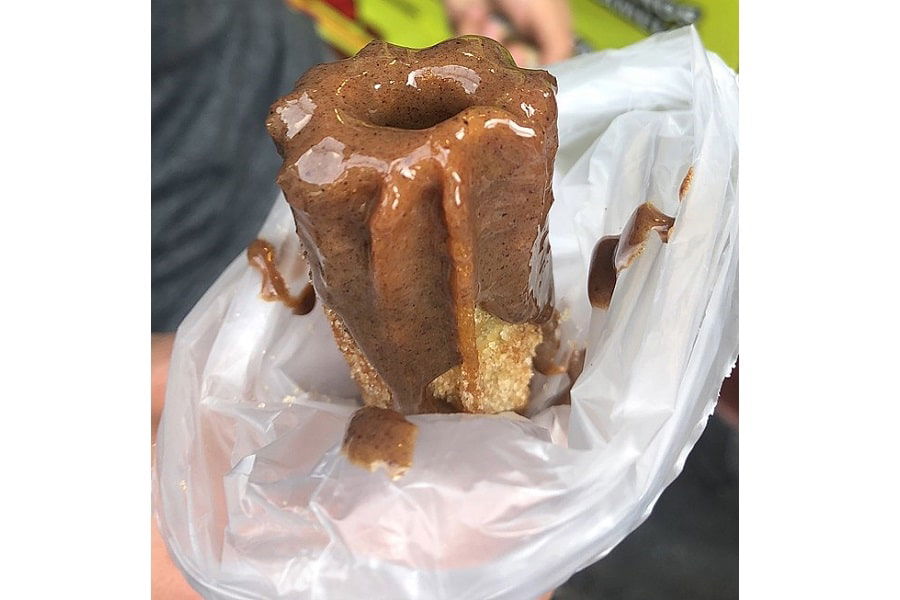
Filled churros take the delight to another level by injecting delicious fillings into the dough. Popular fillings include chocolate, a caramel-like sauce by the name of dulce de leche, fruit compotes, but also cream. The fillings add an extra layer of flavor and texture and can be found in various countries, including Spain, Mexico, and the United States.
The concept of filling churros likely originated in Spain, where churrerías began experimenting with injecting flavors into the dough. The idea of filling pastries has been present in many culinary traditions, and it was natural for churros to follow suit.
Churro Ice Cream Sandwiches
Churros and ice cream come together in the dessert called churro ice cream sandwiches. These creations feature a scoop of ice cream sandwiched between two churros or a churro bun. The combination of the warm, cinnamon-sugar-coated churros with the cold, creamy ice cream is a match made in dessert heaven. This delicious twist on the classic churro has gained popularity in recent years.
READ MORE: Who Invented the Sandwich and Where Did the Sandwich Come From?
Churro Bowls
Lastly, churro bowls offer a delightful combination of textures, with the crispness of the bowl contrasting with the creamy fillings. Churro bowls have become a popular trend in recent years, particularly in the United States and other parts of the world.
The origins of these churro variations are intertwined with cultural and culinary influences from different regions. Churro bowls are a fun and creative way to enjoy churros as a dessert vessel.
The dough is shaped into a bowl and deep-fried until it’s ready to eat. Once cooled, the churro bowl can be filled with various treats such as ice cream, whipped cream, fresh fruit, or even chocolate sauce.